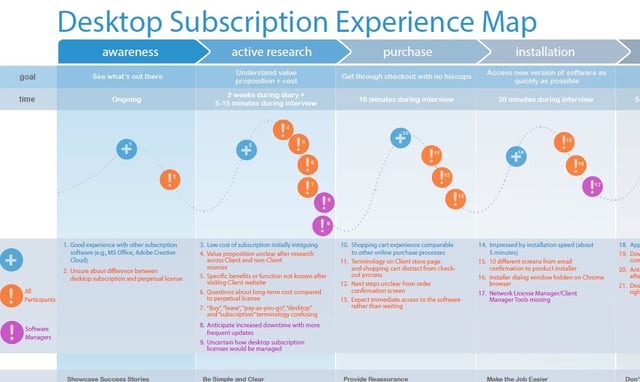Chances are, your organization has talked about creating journey maps, or perhaps has even created them in the past. Visualizing an end-to-end customer experience from your customer’s point of view can help you act on your user research results and fast track customer experience improvements.
That being said, journey maps are not a magic bullet that can elevate any research project. When done at the incorrect time, their creation can waste valuable resources and lead stakeholders down the wrong path. First, we’ll save you some time and tell you two instances where we see clients creating journey maps unnecessarily.
When a journey map won’t add value:
- Your research has a limited scope: When research has a very narrow, tactical focus (i.e., tasks to assess the site’s navigation structure), journey maps cannot be used to their full potential. Vital information will be missing, such as the underlying motivation to complete the tasks in the first place.
- Only one user segment involved: Journey maps are best when trying to get a holistic view of your users and compare behaviors and emotions across segments. When focusing on just one segment, you may miss important observations that could only be discovered with multiple groups (i.e., life stage groups, novice / experts).
Now, let’s talk about some instances when you should absolutely be using journey maps. They are one of the most effective tools for creating empathy for the user and inspiring teams to focus on next steps for improving your users’ journeys.
Here are five instances where journey maps can elevate research.

1. Communicating multiple brand touchpoints across digital and non-digital channels and identifying new opportunities to reach customers
Journey maps help identify all the steps people take in a given activity. They show the ways customers interact with your brand, and where you may find ways to increase engagement through omnichannel experiences.
2. Capturing results of multi-phase research across a period of time
With journey maps, you can explore users’ needs at certain points during their engagement with your site (i.e., research stage, purchase flow, post-purchase). This can help identify ways to maintain brand engagement and encourage brand advocacy.
3. Investing in ethnographic research and you want to ensure the results have legs
Since ethnographic research is very rich in qualitative insights, adding journey maps to an ethnography will allow you to make the most of the emotional responses and previously undiscovered pain points that emerge. The user stories that emerge can be shared with teams throughout your organization, along with prioritized next steps that each team needs to take.
4. Enriching persona development
When you’re developing personas, it is important to compare the similarities and differences between user segments to illustrate specific wants and needs. Journey maps can be used to track both the common journeys as well as idiosyncrasies that emerge for specific segments or sub-segments, helping your stakeholders to identify ways to customize brand experiences.
5. Better understand quantitative data
We all know that quantitative data can be difficult to interpret if you’re not a statistician. Putting your quantitative research findings into journey maps can help stakeholders better understand numbers and percentages, and answer the “why” behind them (i.e., why conversion rate from a specific page is low).
Do you have any other instances where journey maps have worked well (or failed)? Join in on the conversation by telling us on twitter.
Authors

Lauren Foust specializes in qualitative research including in-depth interviews, ethnography, and large-scale international programs across financial services, logistics, and e-commerce. In addition, Lauren is experienced in quantitative methodologies, conducting Information Architecture studies which include strategic design recommendations. Prior to joining AnswerLab, Lauren specialized in contextual inquiry and quantitative research methods at Catalyst Group, where she worked on an interdisciplinary team of interaction designers, visual designers, and strategists.

Deidre Kolarick is a user experience research leader with more than a dozen years experience in professional and academic settings. Since earning her Ph.D. in Cognitive Psychology, she has been teaching research methods at the college level and managing user research projects and teams. At AnswerLab, Deidre leads our New York-based user experience insights team where she uses her analytical skills and consultative approach to develop research solutions to solve clients’ business challenges and ensure overall project success.